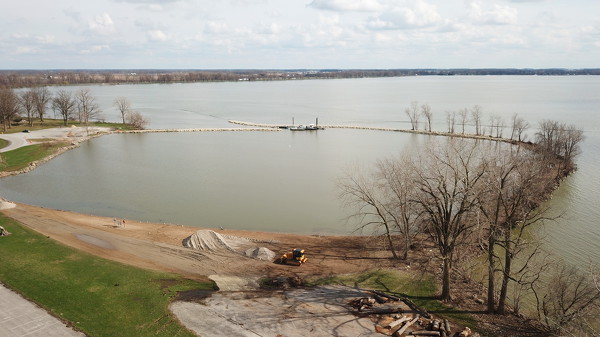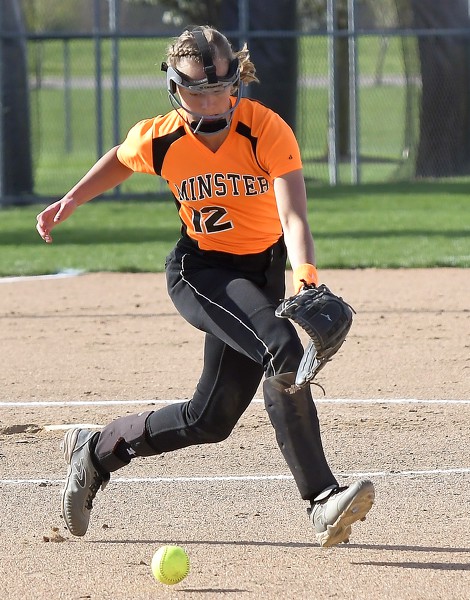Wednesday, April 24th, 2019
Digester interest high, but cost obstacles persist
By William Kincaid
CELINA - Many companies in the last few months have expressed interest in setting up anaerobic digesters in Mercer County to convert manure biogas into energy, Ag Solutions Coordinator Theresa Dirksen told Celina Rotarians on Tuesday.
However, such an operation in itself would not necessarily help area agricultural producers find an efficient and affordable means of moving out of the county an overabundance of manure nutrients responsible for water pollution.
The interest is likely linked to the new MVP Dairy in Neptune, Dirksen said. The multimillion-dollar facility on 82 acres - a collaboration between the VanTilburg family of Celina and the McCarty family of Colby, Kansas - holds more than 4,000 cows.
"(Companies) like this area because we are so livestock dense, and they think that they can put a centralized (digester) facility in," Dirksen said.
Anaerobic digesters turn methane gas from livestock manure into electricity. Unless modified, though, they don't remove all the nutrients.
"It would be great to produce biogas," Dirksen said. "The issue becomes - one pound of phosphorus in a digester is the same pound of phosphorus out of a digester. So we still have to do these nutrient-recovery technologies on the back end of a digester to make it feasible to solve the environmental issue that we're trying to solve."
Many companies interested in digesters don't see the economic benefit of the additional nutrient removal, she said.
"So we really need to find a way to recover the nutrients coming out," she said. "There's lots of other issues with digesters. They want fresh manure so how do we keep our manure fresh and not let it age?"
Transporting the manure to a centralized digester would be costly, too, Dirksen said, explaining that any alternative nutrient-removal system would have to cost less than the penny per gallon most producers pay to land-apply manure to incentivize farmers to get onboard.
"Even if it's 10 miles away, it could cost a penny per gallon to truck that," she pointed out. "Then a lot of these digester companies want to charge a tipping fee, and our producers simply can't afford that."
However, Dirksen, a dairy farmer herself, isn't throwing in the towel any time soon.
"What can we do other than traditional land application with manure to maybe get the nutrients further from the Grand Lake watershed or Mercer County as a whole and do that in an economical fashion for the producers?" she asked.
She continues to seek other nutrient-removing products and procedures across the Midwest that could conceivably be adopted by local farmers. Again, she stressed, it's all about the cost. Many new technologies have been proven to work but are designed for large-scale agriculture operations.
"It's been difficult, to say the least," she said. "There's not much out there that's affordable."
Multiple nutrient-removing technologies have been pilot tested in Mercer County and elsewhere, including centrifuges that operate like washing machines, spinning manure and pushing out solids.
"Typically your nutrients are attached to your solids," she explained. "We want to get the nutrients in the solid form because it's easier to move. Trucking water is expensive."
She's also analyzed a KDS multi-disc roller separator to separate both swine and dairy manure.
"Again, same principle. It's a different type of machine. It's a much cheaper machine. It's got less maintenance issues."
And then there's ultrafiltration equipment that separates raw manure into permeate and concentrate. Ultrafiltration uses no chemicals but contains large motors that are expensive to run.
"The biggest issue we found with this is you end up with two liquid waste streams," she said. "Really, we need something that's in a solid form that we can easily get out of the area."
Of all the potential technologies, all of which work, Dirksen said she's focused mostly on the KDS separator, mostly because of its relative low cost in comparison with the others.
"Because the machine itself is about $60,000 - and that's compared to a centrifuge that's a quarter of a million (dollars), compared to the ultrafiltration at a million dollars for a unit," she said. "There's no farm here that has 1,000 head of swine or 200 head of dairy cows that can afford a quarter-million-dollar machine."
If local officials can find ways to cost-share a separator through state and federal programs, then "maybe it is affordable and we can move the needle on getting some nutrients further away from the watershed."
Phosphorus-fed toxic blue-green algal blooms have resulted in state-issued water advisories on Grand Lake every year since 2009 and millions of dollars in lost tourism on the 13,500-acre lake. On Jan. 18, 2011, the state designated the local watershed distressed after humans and animals in 2010 had been sickened by blue-green algae in the lake. This triggered new rules for watershed farmers, including mandatory nutrient-management plans involving soil tests and restricting manure application.
In July 2006, the Mercer County Soil and Water Conservation District board of supervisors hired Dirksen to the then-new position of Grand Lake/Wabash Watershed coordinator.
She later was promoted to agency technician, and she worked closely with agricultural producers on conservation issues and projects. She was then elevated to engineer after obtaining her state professional engineer license in 2009 before being appointed the full-time Ag Solutions coordinator.
Ag Solutions formed in 2011 as a voluntary group of farmers looking for ways to improve water quality in the Grand Lake watershed.
"They were trying to be proactive and show that agriculture does care about water quality, and they continue to care about water quality," Dirksen told Rotarians.
County commissioners later made the Ag Solutions director position a full-time job.
"I would agree it is very important; we need to sustain agriculture that we have here," she said. "Obviously we know it's intense - lots of livestock. But we need to do it while we're being environmentally friendly and improving water quality."
Removing nutrients from the Grand Lake watershed and/or Mercer County is paramount, she said.
"The reason we need to do this is our soil test levels are higher here in this area than they are anywhere else in the state of Ohio," she said.
She attributed that fact primarily to the growth of poultry production in the 1980s and '90s.
"Producers weren't educated on the nutrient value at that time of the manure, and there was a lot of overapplication going on … and we built up our soil test levels higher that what they need to be to grow good crops."


